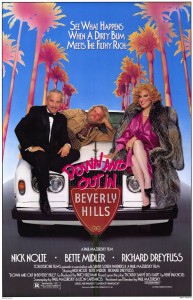Down and Out in Beverly Hills (1986)
“I ate garbage for dinner last night, Barbara — and I liked it!”
|
Synopsis: |
|
Genres, Themes, Actors, and Directors:
Response to Peary’s Review: I agree with Peary that the film’s humor is often overly broad (those dog shots certainly feel gratuitous and repetitive) — but overall I find this to be a rare example of a (mostly) successful updated remake. There are quite a few scenes that ring true and seem to respectfully highlight important nuances in class relations. In one scene, for instance, a cleaned-up Nolte is having lunch with Dreyfuss at a swanky Beverly Hills restaurant when he notices his homeless buddy Al (Felton Perry) walking by. Perry and Nolte are thrilled to see each other, and Perry comes inside to join them — but, to Dreyfuss’s astonishment, he politely refuses an offer of lunch (though he does steal bread rolls from various tables on his way out). Dignity of a sort is maintained, with Nolte openly acknowledging his humble origins (rather than maintaining a new facade of wealth), and Perry demonstrating self-sufficiency in the face of charity. Indeed, part of what makes Nolte’s character so oddly appealing is his refusal to “take advantage” of anything offered to him: he accepts Dreyfuss’s offer of food, clothing, and shelter, but it’s understood that he’ll leave whenever he pleases, and is unwilling to become the object of anyone’s pity or derision. He’s a refreshingly unique protagonist, and makes the film worth a one-time look. Redeeming Qualities and Moments:
Must See? Categories
Links: |


One thought on “Down and Out in Beverly Hills (1986)”
First viewing. Not must-see.
An opposite view here:
Largely filmed with a pastel patina, giving the elegant appearance of being inviting… the film simply isn’t. It’s not quite as dreadful as a number of other Mazursky films but that’s not saying much. It’s not particularly funny and the cast often feels desperate (with perhaps the exception of Nolte – but, like everyone else, he isn’t given anything all that interesting to say).
At one point, the Dreyfuss character says that he feels as though he has been married to his wife “forever”. That’s how it feels watching this flick; there’s nothing fresh or surprising in it and it just sort of plods along to an unsatisfying conclusion.